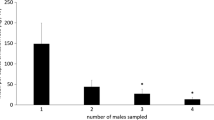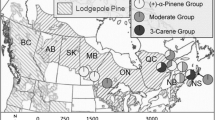Abstract
Exposure to artificial changes in atmospheric pressure depressed the responsiveness of bark beetles to their aggregation pheromones.Scolytus multistriatus andIps pini held for 30 min in desiccator jars in which the pressure was modified ±25 mm experienced an inverse change when they were removed for laboratory bioassay. Relative response to pheromones among treatment groups of both species was as follows: ambient > increased > decreased > increased and decreased. In one series of 20 bioassays, response ofS. multistriatus was significantly higher for 9 tests during which no change in atmospheric pressure was detected, as compared to 11 tests during which there was a change in barometric reading. However, in another series of tests withS. multistriatus and a series withI. pini, no depression in response was associated with natural barometric shifts. Large air bubbles in the foregut (ventriculus) confirmed that both beetle species swallow air in preparation for flight. The hypothesis advanced by other workers, that bark beetles may detect changes in atmospheric pressure by shrinking and swelling of the ventricular air bubbles, is consistent with our observations. Sensitivity to atmospheric pressure fluctuations may be the mechanism by which response in laboratory bioassays is depressed during stormy weather and flight in nature is concentrated in periods of calm air.
Similar content being viewed by others
References
Atkins, M.D. 1966. Laboratory studies on the behavior of the Douglas-fir beetle,Dendroctonus pseudotsugae Hopkins.Can. Entomol. 98:953–991.
Bennett, R.B. andBorden, J.H. 1971. Flight arrestment of tetheredDendroctonus pseudotsugae andTrypodendron lineatum (Coleoptera: Scolytidae) in response to olfactory stimuli.Ann. Entomol. Soc. Am. 64:1273–1286.
Chapman, J.A. 1955. Physiological and biological studies on the ambrosia beetle,Trypodendron lineatum (Oliv.) and the Douglas-fir beetle,Dendroctonus pseudotsugae Hopk.Can. Dep. For. Rural Dev. Bi-Mon. Res. Notes 11:2.
Elliott, E.W. 1973. Factors affecting attraction ofScolytus multistriatus (Marsham) (Coleoptera: Scolytidae) to female pheromone. MS thesis, SUNY College of Environmental Science and Forestry, Syracuse 49 pp.
Graham, K.P. 1961. Air swallowing: A mechanism in photic reversal of the beetleTrypodendron.Nature (London) 191:519–520.
Henson, W.R. 1951. Mass flights of the spruce budworm.Can. Entomol. 83:240.
Lanier, G.N., Silverstein, R.M., andPeacock, J.W. 1976. Attractant pheromone of the European elm bark beetle (Scolytus multistriatus): Isolation, identification, synthesis, and utilization studies, pp. 149–175,in J.E. Anderson and H.K. Kaya (eds.). Perspectives in Forest Entomology. Academic Press. New York.
Lanier, G.N., Gore, W.E., Pearce, G.T., Peacock, J.W., andSilverstein, R.M. 1977. Response of the European elm bark beetle,Scolytus multistriatus (Coleoptera: Scolytidae), to isomers and components of its peromone.J. Chem. Ecol. 3:1–8.
Mason, R.R. 1970. Comparison of flight aggregation in two species of southernIps (Coleoptera: Scolytidae).Can. Entomol. 102:1036–1041.
Meyer, H.J., andNorris, D.M. 1964. Dispersal of the pathogen and vectors of Dutch elm disease.Proc. North Cent. Branch Entomol. Soc. Am. 19:26–29.
Moeck, H.A. 1970. An olfactometer for the bioassay of attractants for scolytids.Can. Entomol. 102:792–976.
Peacock, J.W., Cuthbert, R.A., Gore, W.E., Lanier, G.N., Pearce, G.T. andSilverstein, R.M. 1975. Collection on Porapak Q of the aggregating pheromone ofScolytus multistriatus (Coleoptera: Scolytidae).J. Chem. Ecol. 1:149–160.
Sutton, O.G. 1960. Atmospheric Turbulence. John Wiley and Sons, New York. 111 pp.
Vité, J.P., Gara, R.I., andvon Scheller, H.D. 1964. Field observations on the response to attractants of bark beetles infesting southern pines.Contrib. Boyce Thompson Inst. 22:461–470.
Wallace, P. 1940. Notes on the smaller European elm bark beetle,Scolytus multistriatus Marsham.Conn. Agric. Exp. Stn. Bull. 434:293–311.
Wellington, W.G. 1946. The effects of variations in atmospheric pressure upon insects.Can. J. Res. Sect. D 24:51–70.
Author information
Authors and Affiliations
Additional information
Coleoptera: Scolytidae.
This study was supported in part by the Northeastern Forest Experiment Station, USDA Forest Service under cooperative work agreement 23-509.
Rights and permissions
About this article
Cite this article
Lanier, G.N., Burns, B.W. Barometric flux. J Chem Ecol 4, 139–147 (1978). https://doi.org/10.1007/BF00988050
Received:
Revised:
Issue Date:
DOI: https://doi.org/10.1007/BF00988050




